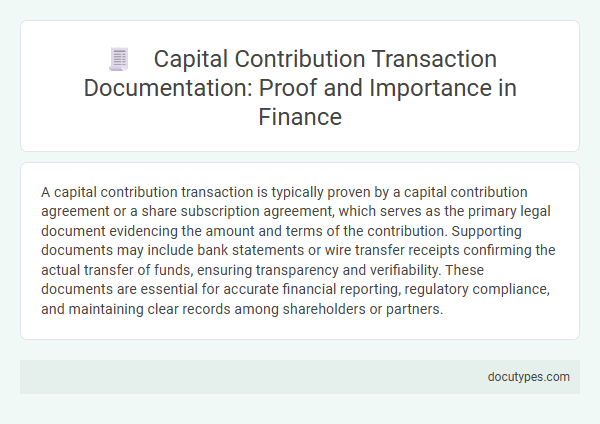A capital contribution transaction is typically proven by a capital contribution agreement or a share subscription agreement, which serves as the primary legal document evidencing the amount and terms of the contribution. Supporting documents may include bank statements or wire transfer receipts confirming the actual transfer of funds, ensuring transparency and verifiability. These documents are essential for accurate financial reporting, regulatory compliance, and maintaining clear records among shareholders or partners.
Understanding Capital Contribution Transactions in Finance
In finance, a capital contribution transaction occurs when an owner or investor provides funds or assets to a company in exchange for equity. Understanding the documentation that serves as proof for these transactions is essential for accurate record-keeping and legal validation.
- Capital Contribution Agreement - This document outlines the terms and conditions under which an investor contributes capital, serving as formal evidence of the transaction.
- Board Resolution - A record of the company's approval of the capital contribution, confirming internal consent to the investment.
- Bank Statements or Transfer Receipts - Financial records that provide tangible proof of the actual transfer of funds or assets into the company's accounts.
Key Components of Capital Contribution Documentation
| Document Type | Key Components | Purpose in Capital Contribution Transactions |
|---|---|---|
| Capital Contribution Agreement |
|
Serves as the primary legal proof of a capital injection into the company, outlining responsibilities and rights of parties involved. |
| Shareholder Resolution |
|
Confirms that the capital contribution has been officially authorized within the company's governance framework. |
| Transaction Receipt or Deposit Slip |
|
Provides tangible proof of the actual transfer of funds into the company's bank account. |
| Asset Transfer Documents |
|
Verifies ownership change and valuation of non-cash assets contributed as capital. |
| Updated Capital Ledger or Register |
|
Maintains an official record reflecting the impact of the contribution on ownership structure. |
Your proof for capital contribution transactions primarily relies on formal documentation showcasing the transfer details, valuations, and authorizations. Proper records are essential for financial clarity and legal compliance.
Legal Proof of Capital Contributions: Essential Documents
Legal proof of capital contributions is vital for validating financial transactions within a company. These documents establish the commitment and fulfillment of funds or assets by shareholders.
The primary document serving as proof for capital contribution transactions is the Capital Contribution Agreement. This agreement outlines the amount, form, and timing of contributions made by investors. Supporting documents such as bank statements, share certificates, and board resolutions further substantiate the transaction's legitimacy.
Importance of Accurate Capital Contribution Records
The primary document serving as proof for capital contribution transactions is the Capital Contribution Agreement or a signed Resolution from the company's board. This document details the amount, nature, and terms of the contribution, providing legal validation of the transaction.
Accurate capital contribution records are vital to ensure clear ownership percentages and compliance with regulatory requirements. Your financial statements rely on precise contributions to reflect the company's equity correctly and support audits and investor relations.
Regulatory Requirements for Capital Contribution Documentation
What document serves as proof for capital contribution transactions? Regulatory requirements mandate thorough documentation to verify the legitimacy and accuracy of capital contributions. Your capital contribution is typically evidenced by a share subscription agreement or a capital contribution agreement, which must comply with local corporate laws and financial regulations.
Common Types of Capital Contribution Evidence
Common types of capital contribution evidence include signed subscription agreements, bank statements showing fund transfers, and official share certificates. Subscription agreements outline the investor's commitment and terms of contribution, serving as primary legal proof. Bank statements confirm the actual transfer of funds, while share certificates represent ownership and equity rights in the company.
Risks of Inadequate Capital Contribution Documentation
In finance, the primary document that serves as proof for capital contribution transactions is the Capital Contribution Agreement. This agreement outlines the amount, form, and timing of the capital injected by investors or partners into a company.
Inadequate documentation of capital contributions can lead to significant legal and financial risks, including disputes over ownership percentages and challenges in securing further investment. Lack of clear records may also result in regulatory penalties and complications during audits or corporate restructuring.
Best Practices for Documenting Capital Contributions
In finance, the primary document serving as proof for capital contribution transactions is the capital contribution agreement, which outlines the terms and details of the investment made by shareholders or partners. Best practices for documenting capital contributions include maintaining clear, signed agreements that specify the amount contributed, date of transaction, and the contributing party's details to ensure transparency and legal compliance. Proper documentation supports accurate financial records, facilitates audits, and protects both the company and investors in case of disputes.
Role of Capital Contribution Proof in Audits and Compliance
Documentation proving capital contribution transactions is essential for verifying ownership stakes and financial commitments within a company. Such proof is crucial during audits and regulatory compliance reviews to ensure accuracy and transparency in financial reporting.
- Capital Contribution Agreement - This legal document outlines the terms and conditions of the capital invested by shareholders or partners.
- Bank Statements or Deposit Slips - These documents provide tangible evidence of the funds transferred into the company's accounts.
- Shareholder or Partner Resolutions - Official records that approve and confirm the receipt of capital contributions.
Your ability to present clear and verifiable proof facilitates smooth audits and maintains regulatory compliance in your financial operations.
What Document Serves as Proof for Capital Contribution Transactions? Infographic

